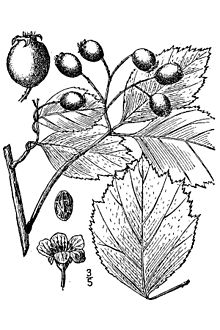|
Crataegus douglasii
Crataegus douglasii is a North American species of hawthorn known by the common names black hawthorn and Douglas' thornapple. It is most abundant in the Pacific Northwest. DescriptionCrataegus douglasii is a compact erect bushy shrub growing to 8–9 metres (26–30 feet) tall with a trunk of up to 10 centimetres (4 inches) thick.[4] It is covered in fan-shaped green leaves about 2.5–5 cm (1–2 in) long[4] with teeth along the distal margin. Thorns along the branches are 1–2.5 cm long.[4] White flowers with greenish centers grow in bunches at the ends of each thin branch. The fruit is a blackish pome up to about 1 cm across, containing 3–5 rocklike seeds.[4] TaxonomyThe species is named after David Douglas, who collected seed from the plant during his botanical explorations.[5] Formerly placed within the species, Crataegus douglasii var. duchesnensis is now considered to be a synonym of Crataegus saligna. DistributionThe thorny shrub is native to northern and western North America, where it grows in varied habitats from forest to scrubland. It is most abundant in the Pacific Northwest. EcologyThe foliage is browsed by cattle and sheep. Various birds, including quail, the Hungarian partridge, and ring-necked pheasant feed on the berries,[5][6] as do bears and other animals.[4] Magpies nest in the branches.[4] The species is a larval host to the gray hairstreak, mourning cloak, pale tiger swallowtail, and western tiger swallowtail.[7] UsesThe fruits were a good food source for Native American peoples such as the Cheyenne and Nlaka'pamux.[citation needed] Gallery
See alsoReferencesWikimedia Commons has media related to Crataegus douglasii.
External links
|
||||||||||||||||||||||||||||||||||||||||
Portal di Ensiklopedia Dunia



![Straight, stout thorns are one to two centimeters long.[8]](http://upload.wikimedia.org/wikipedia/commons/thumb/0/0a/Crataegus_douglasii_9816.JPG/80px-Crataegus_douglasii_9816.JPG)




![The mature bark is grey and rough.[9]](http://upload.wikimedia.org/wikipedia/commons/thumb/f/f4/Crataegus_douglasii_mature_bark.jpg/104px-Crataegus_douglasii_mature_bark.jpg)



